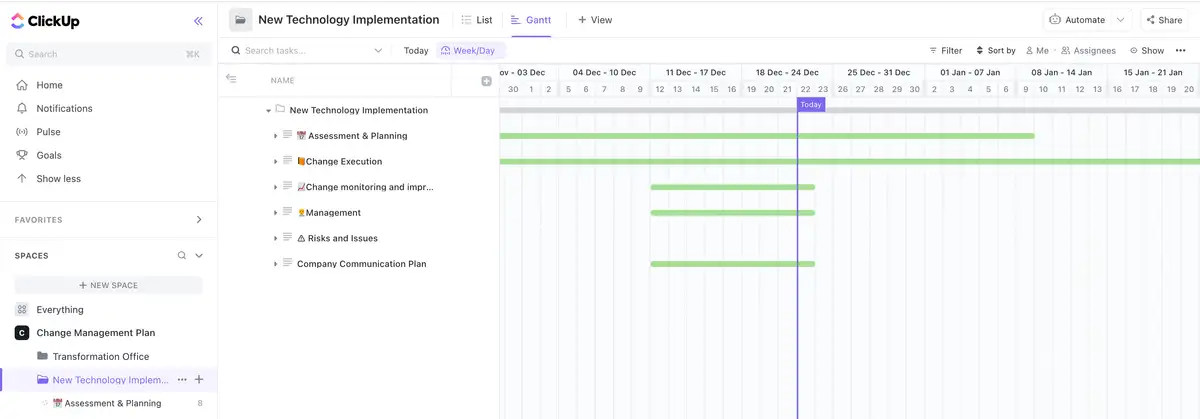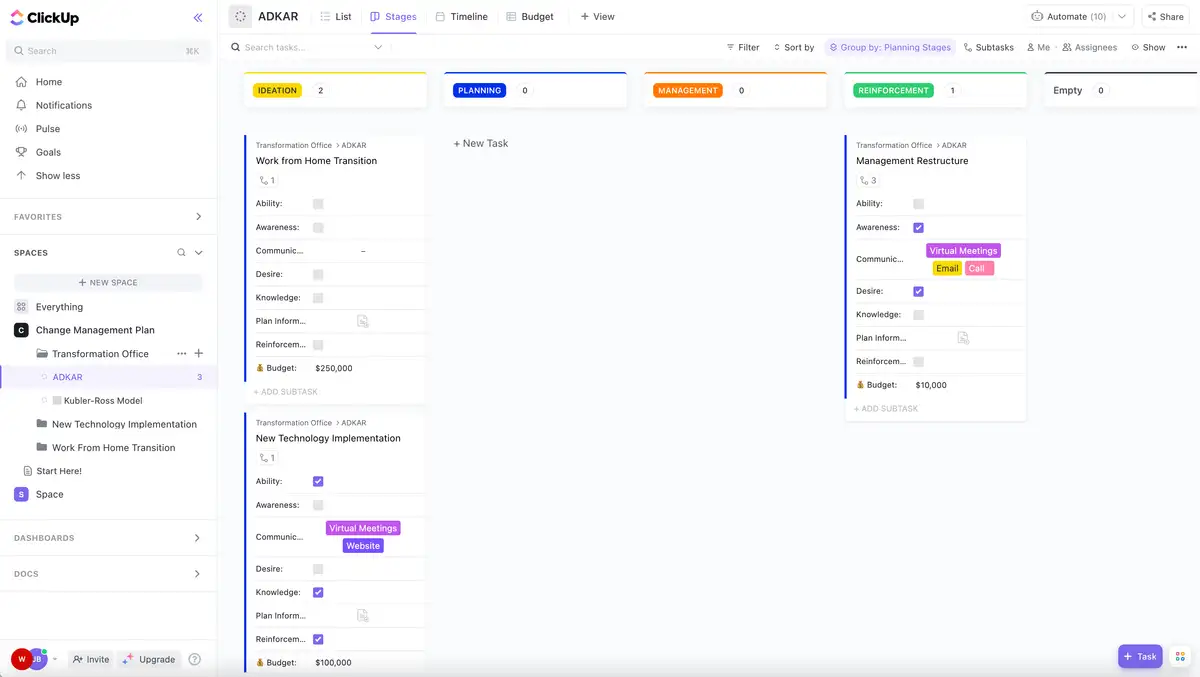Do you find that the employees in your organization have the knowledge and experience to get the job done, but they're missing some key skills necessary to gain a competitive edge? It could be hindering productivity and preventing your business from reaching its full potential. Don't worry—you're not alone!
More and more organizations are facing the challenges of a constantly changing marketplace that often requires specialized skills. But with some smart strategies for managing talent within an organization, it's possible to create an environment where everyone can thrive and reach their ultimate business goals. So if you’re looking for actionable advice on bridging the skills gap between teams or employees within your organization, ClickUp's skills gap analysis template is for you!
What is a change management plan?
A change management plan is a document that outlines how an organization will manage and implement changes. It should include detailed steps and strategies for transitioning from the current state to the desired state, as well as plans for monitoring progress and providing feedback along the way.
The main goal of a change management plan is to ensure smooth transitions within an organization while minimizing disruption and maximizing successful outcomes. The plan should be tailored to the specific needs of the organization, taking into account factors such as size and complexity of the organizational change, budget limitations, timeline requirements, risk management considerations, stakeholder engagement strategies and more.
The organizational change process will require many stakeholders to be on the same page, be it the change control board, project managers, and change managers.

Pictured: Plan overview in List view in ClickUp's change management plan template.
The benefits of having a change management plan
Successful change is hard, but having a plan to manage it makes it a whole lot easier. Specifically, a change management plan enables you to:
Provide clarity on the desired outcomes of a proposed change, helping to keep everyone focused
Help stakeholders understand their roles and responsibilities in making the transition successful.
Have a great change management communications plan to keep all relevant parties informed
Facilitate collaboration throughout the process by providing a platform for feedback and dialogue
Ensure a smooth and successful transition, reducing disruption and maximizing positive outcomes.
The main elements of a change management plan
Now that you know why you should have a change management plan to oversee any organization transition, it's time to learn what goes into it. You should use change management plan templates that include:
A clear timeline with milestones for tracking progress.
An analysis of the current state and the desired future state.
Risk management considerations
and strategies.
Stakeholder engagement plans, including communication protocols and feedback loops.
Logistical plans for implementing changes on the ground
Change management tools that will be required to implement the process

Pictured: A Gantt chart for tracking new technology implementation in ClickUp's change management plan template.
How to create a change management plan?
As a change leader, putting together your change management plan can take some effort, so it helps to follow these steps and answer some key questions along the way.
- Define the desired outcome.
Ask yourself: What is the goal of the change initiative?
Use Docs in ClickUpto brainstorm
with your team about change goals and priorities.
- Analyze the current state.
Ask yourself: What resources, processes, and systems are currently in place and how do they need to be changed?
Create a Dashboard in ClickUp
to get data-driven insights at a glance.
Collect feedback
from many parties by creating a change request form with ClickUp Forms.
- Develop a timeline for implementation.
Ask yourself: How long will this take and what milestones should be tracked along the way?
Use Calendar view in ClickUp
to chart out your timeline.
- Identify stakeholders.
Ask yourself: Who will be affected and how should they be kept informed?
Assign users to tasks in ClickUp
so they can track progress, make updates, and stay in the loop.
- Develop risk management plans.
Ask yourself: What potential risks need to be addressed, and what strategies can help mitigate them?
Create custom fields in ClickUp to track different risk categories.
- Compile logistical requirements:
Ask yourself: What resources (both human and material) are needed for successful implementation?
Use Gantt charts in ClickUpto allocate resources
more effectively.
- Develop a communication plan.
Ask yourself: How can stakeholders provide input during the process?
Tag key stakeholders on any updates in task comments in ClickUp
to ensure they get automatically notified when something changes.
- Monitor progress and adjust plans as needed.
Ask yourself: How will you track success, and what changes need to be made if goals are not achieved?
Create custom statuses in ClickUp
that track progress on tasks.
- Develop an evaluation plan.
Ask yourself: What criteria will be used to assess the results of the change initiative when it is complete?
Use a Dashboard in ClickUp to surface insights
about the initiative's success.
- Document the change management process.
Ask yourself: How will you document your plans and results for future reference?
Use Docs in ClickUp to record learnings
and develop procedures for future plans.
How often should the change management plan be updated?
The change management plan should be updated as needed throughout the process. As new information is gathered or goals are adjusted, the plan should be adjusted accordingly to ensure that it remains relevant and accurate.
Additionally, updates should be made at key milestones in order to assess progress and make any necessary modifications. It's important to stay flexible and open to changes throughout the process, as even well-crafted plans cannot anticipate every potential outcome.
Finally, it's a good idea to document all changes in the plan for future reference and review. By staying on top of updates and continually monitoring progress, organizations can ensure that their change management initiatives are successful and sustainable.
How technology solutions can help with change management plans.
Technology solutions like ClickUp can make the change management process easier and more effective. With its customizable change management plan template, you can streamline your entire transition process. You can quickly create tasks, set due dates and milestones, assign roles and responsibilities to stakeholders, track progress in real-time, share important files with relevant parties and manage resources more efficiently.
All of this information is kept in a centralized platform, so everyone has access to the same data and can stay on top of changes as they happen. Additionally, ClickUp's interface allows you to easily monitor progress and make adjustments quickly when needed—for example, if certain tasks are taking longer than anticipated or risk factors need to be addressed. This helps ensure a smoother and more successful transition for your organization.
Best practices for change management planning
Staying on top of your change management plan can be tough, but these tried-and-true tips can help you achieve success:
Develop clear goals and objectives before starting the process
Include stakeholders in the planning process to get their input and buy-in
Use a comprehensive project management tool like ClickUp to track progress and manage resources
Keep everyone informed of changes throughout the process
Make sure all relevant personnel receive adequate training prior to implementation
Establish a feedback loop to allow stakeholders to provide input and monitor progress
Have contingency plans in place for potential risks or unplanned events
Celebrate successes at each milestone of the process
Document the change management process for future reference

Pictured: Planning in Stages view in ClickUp's change management plan template.
Common pitfalls of change management planning.
One of the most common pitfalls in change management planning is failing to include stakeholders in the process. Without proper buy-in from those impacted by the transition, it can be difficult for organizations to get everyone on board and ensure successful implementation.
Another issue is inadequate training; if personnel are not adequately prepared for the changes, they may be unable to take effective action or may even sabotage the process. Poorly designed risk management plans can also leave organizations vulnerable to unexpected obstacles, which can significantly reduce the chances of success. Additionally, ineffective communication and feedback loops can lead to misunderstandings and miscommunications between stakeholders, leading to further delays.
Finally, if processes are not properly monitored and tracked it's difficult to measure progress and make adjustments as needed. Ultimately, having a comprehensive change management plan in place can help an organization avoid these pitfalls and ensure smooth transitions with minimal disruption.
Key takeaways
An effective change management plan is key for any organization that wants to ensure smooth transitions and successful outcomes. A comprehensive plan should include a timeline with milestones, risk management strategies, stakeholder engagement plans, logistical requirements, feedback loops and more.
Technology solutions such as ClickUp's change management plan template can make the process easier by providing a centralized platform for tracking progress and managing resources. By following best practices and avoiding common pitfalls, organizations can maximize their chances of success as they transition between phases. With the right plan in place, any organization can be well-prepared to take on large-scale changes with confidence!







